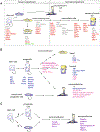Exploring the origins of the normal prostate and prostate cancer stem cell
- PMID: 18563640
- PMCID: PMC11075662
- DOI: 10.1007/s12015-008-9033-1
Exploring the origins of the normal prostate and prostate cancer stem cell
Erratum in
- Stem Cell Rev. 2008 Dec;4(4):329
Abstract
Prostate epithelial stem cells (PSCs) are primed by the urogenital mesenchyme to initiate bud formation and branching morphogenesis, ultimately culminating in a glandular structure composed of luminal, basal and neuroendocrine cells. Identity of this cell has remained elusive however cell populations enriched for cells exhibiting stem cell characteristics express the stem cell markers CD133(+), alpha2beta1(hi), CD44 and Sca-1 along with embryonic stem cell factors including Oct-1, Nanog, Sox2 and nestin. Androgens are critical to prostate organogenesis and play a major role in normal prostate function and the development of prostate cancer. Cell lineage is another variable in the development of prostate cancer. This review discusses the embryonic prostate stem cell niche, normal prostate development, isolation and characterization of normal prostate and prostate cancer stem cells, and current concepts on the origin of prostate cancer.
Figures



References
-
- Clarke MF, Dick JE, Dirks PB, et al. (2006). Cancer stem cells—perspectives on current status and future directions: AACR Workshop on cancer stem cells. Cancer Research, 66, 9339–9344. - PubMed
-
- Bell DR, & Van Zant G (2004). Stem cells, aging, and cancer: inevitabilities and outcomes. Oncogene, 23, 7290–7296. - PubMed
-
- Feinberg AP, Ohlsson R, & Henikoff S (2006). The epigenetic progenitor origin of human cancer. Nature Reviews Genetics, 7, 21–33. - PubMed
-
- Kellokumpu-Lehtinen P, Santti R, & Pelliniemi LJ (1979). Early cytodifferentiation of human prostatic urethra and Leydig cells. Anatomical Record, 194, 429–443. - PubMed
-
- Kellokumpu-Lehtinen P (1983). Localization of acid phosphatase activity in testosterone-treated prostatic urethra of human fetuses. Prostate, 4, 265–270. - PubMed
Publication types
MeSH terms
Grants and funding
LinkOut - more resources
Full Text Sources
Other Literature Sources
Medical
Research Materials
Miscellaneous
